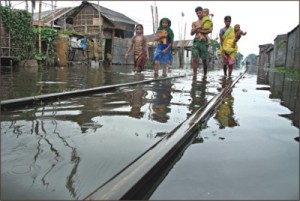Waterlogging in Capital
Clogged drains, filled up canals blamed
 Clogged and inadequate drainage system and filling up of most of the city canals are mainly responsible for waterlogging in the city.
Clogged and inadequate drainage system and filling up of most of the city canals are mainly responsible for waterlogging in the city.
The city drainage system has not improved with the pace of rapid growth of urbanisation while most of the canals out of around 50 in the city have either been filled up entirely or partially over the last two decades, said experts.
Low-lying areas including eastern fringe of the city are still being filled up in the name of development contributing to waterlogging, they said.
Around 10 canals of the city have either been filled up totally or turned into box culverts to construct roads which has aggravated waterlogging, said experts and officials of Dhaka Water Supply and Sewerage Authority (Wasa).
Roads were constructed in Rayerbazar, Rajabazar, Gopibagh and Shyampur Kadamtala by filling up canals and constructing storm water and sewerage lines.
Width of Segunbagicha canal, Dholai Khal-1, Dholai Khal-2, Debdholai Khal and Paribagh canal have been narrowed down for building box culverts. The water under the culverts remains clogged due to lack of maintenance, they said.
Wasa had earlier taken initiatives in line with a decision of the last caretaker government to recover 26 out of 43 canals from encroachers.
However, the initiatives have so far yielded very little success. Besides, once the recovery drive is over, many of the canals again get choked up or encroached due to lack of excavation, proper demarcation and monitoring, experts said.
According to experts, 150 square kilometers area of the city under Wasa requires around 350 km storm drainage line, whereas presently it has now only 285 km drainage line.
“About 90 km more storm water line of WASA is needed to be set up at different areas to strengthen the drainage system,” said an official of Wasa.
Besides, the existing water pipes should also be replaced by bigger ones so that they discharge more waters as most of the water bodies have been filled up at many places,” added the official.
Dhaka Wasa had 135 km drainage line in 1990, which is now 265 km but the population in the capital has gone up to 1.20 crore from that of 68.44 lakh in 1991, said officials of Wasa and Rajuk.
In many places where there is no drainage system of WASA, DCC covers the area by pipe drains or surface drains, they said.
Wasa is responsible mainly for maintaining city’s drainage system cleaning them once in a year but most of the time 50 percent of the drains remain clogged due to manual work, said architect Iqbal Habib, joint secretary of Bangladesh Paribesh Andolon.
DCC also does not get them cleaned properly, which is also a reason of waterlogging, said Habib.
He said an integrated master plan is very necessary to save the city from waterlogging.
Habib said Wasa conducts drives only to recover canals but their water retention capacity has reduced due to lack of excavation.
Construction of box culvert was also a totally wrong plan, as the passages under these culverts are not cleaned leaving them choked up round the year resulting in water stagnation, he said.
Wasa has two permanent pump stations at Dholai Khal, and Kolyanpur while Bangladesh Water Development Board runs another pump house at Goran Chatbari in Mirpur.
Apart from them, there are two more temporary pump stations at Rampura and Janapath in Kamalapur, he said.
According to the official figures Wasa has now 285 km long pipe drains, 65 km drain and 9 km box culverts while DCC has 999.468 km open drain and 1052.198 km pipe drain.
But as there is a lack of coordination between Wasa and DCC the drainage management system suffers heavily worsening the waterlogging in the city, sources of both Wasa and DCC said.
DCC Mayor Sadeque Hossain Khoka said the drainage system should come under one umbrella to get better result and drive to recover canals from encroachers is also very important.
State Minister for LGRD and Cooperatives Jahangir Kabir Nanok said they had already started the drive to recover all the 43 canals of the city.
He said they would take proper steps to prevent re-encroachment.




















